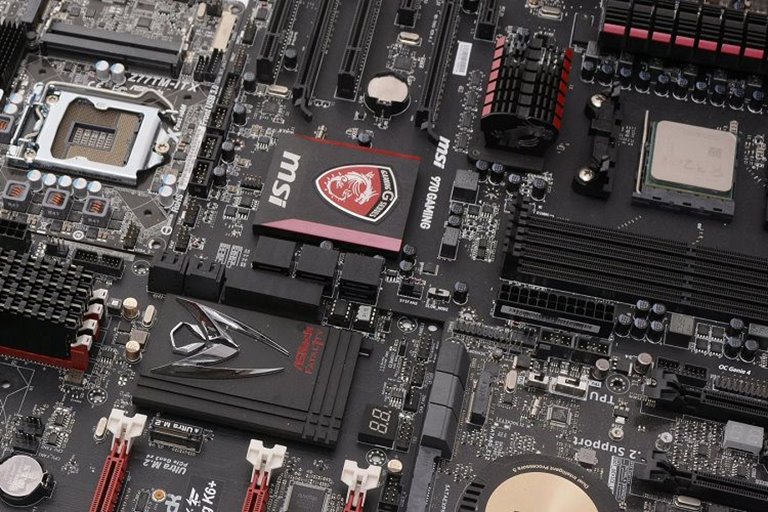Which Motherboard Should We Buy With Which Processor?
Choosing The Right Motherboard Always Seems Difficult And Confusing For A Group Of Users. How To Choose The Best Motherboard To Buy Or Upgrade Your PC?
Motherboard, If you have ever wanted to buy or buy PC parts, you must have seen that Intel and AMD are the only PC processor manufacturers in the world with the conventional x86 architecture, and each has its own processor sockets. These sockets are updated from time to time. The chipset or set of chips that support each new generation of processors may differ from the previous generation and may not support older models.
The variety of sockets, motherboard chips, and processors of each generation makes ordinary buyers need to know the basic information about motherboards and chip suits to suit the processor when choosing a processor for their system.
Mostly technical information that includes some constructive standards and includes different technical and ancillary specifications. Here we try to address these differences and points that should consider in choosing compatible processors and motherboards.
Sockets on AMD and Intel processors
The processors of recent years made by Intel are pinless ( Land Grid Array or LGA ), and the processors made by AMD are pinned ( Pin Grid Array or PGA). Therefore, each has its own sockets. . Of course, these sockets are not compatible. You can not even mistakenly install the AMD processor in the motherboard socket of the Intel processor.
But sometimes it is possible, for example, that the processor can be installed in a dedicated socket, but does not work on the motherboard, simply because the motherboard BIOS does not support the processor model. Therefore, it is not the case that the functionality of a processor can be guaranteed just by the fact that it can install aboard. Each processor is only compatible with a specific set of chips that must be known before purchase and the difference between them and the target market of each.
The chipset on the motherboard
Or chipset Chipset system consists of electronic components placed on an integrated circuit or IC to flow data between the main processor, memory, and peripheral control components. Also, chipsets are usually designed to work with a specific series of one or more generation processors.
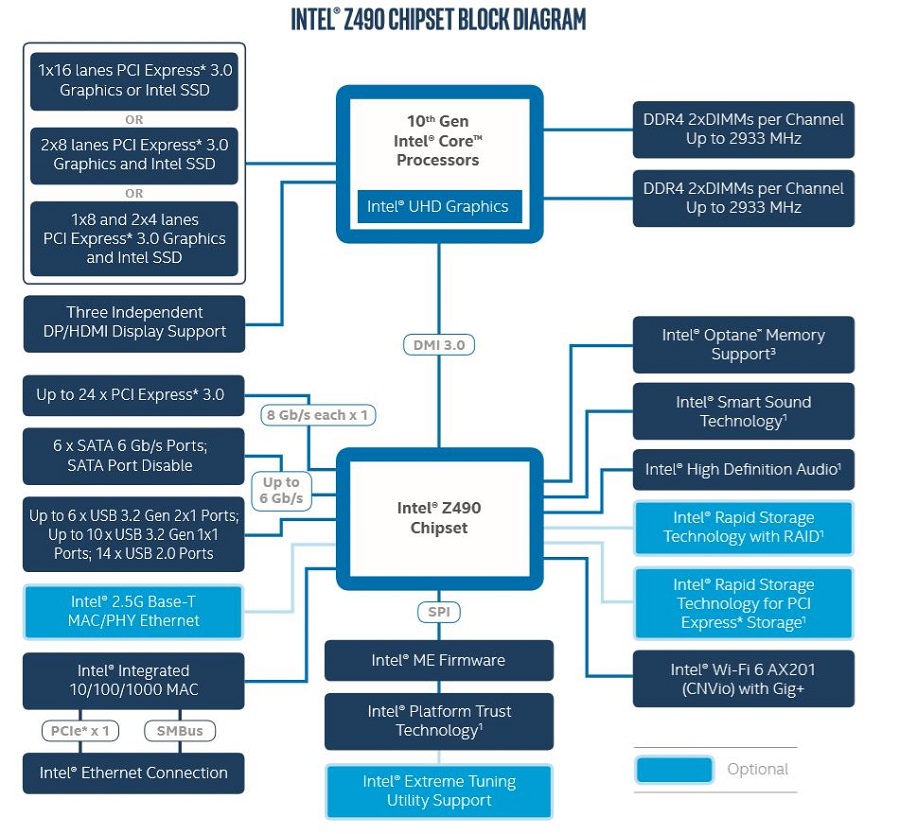
Design diagram and capabilities of Z490 chipset or chipset
On conventional x86 computers, the CPU’s main bridge to the rest of the system was via a northbridge built into the motherboard, thus directly managing the connection between the CPU and RAM and the connected high-speed busses such as the AGP or PCIe slot. And controlled and therefore played a vital and decisive role in system speed. But today, the northbridge of the chipset or chip assembly has been moved into the processor to perform its tasks with much less delay and more speed. The company first introduced this change by releasing the Athlon 64 processorDigit and moving the memory controller into the processor. But some operations that could not be done directly by the North Bridge were left to the Southbridge. Slower system components such as SATA and USB ports are still parts of the system that the South Bridge still controls, and the South Bridge connection to the North Bridge is via a PCI bus, or more recently DMI (short for Direct Media Interface, which is very similar to PCI). Express) is established.
With the advancement of processors and the introduction of faster standards, the control of the graphics card bus was removed from the functions of the North Bridge and transferred to the processor. Hence, the processor could control the graphics card directly, leaving less work for the north and south bridges. So the developers decided to combine the functions of the two chips and offer a single chip for it. This single chip is now called PCH (short for Platform Controller Hub) and is produced as a single chip in all modern motherboards with newer processors, but it is still quite common to use the name chipset. Of course, in mobile processors, the PCH chip has recently been paired with the main processor to make it less expensive to install and use on integrated boards and in limited space.
Intel-compatible chipsets
The modern era of popular Intel processors began in 2008 with the release of the Nehalem architecture after the release of the Core series. Intel has since exclusively produced the set of chips needed for its processors, and the processors supported by these chipsets also include one or two generations of them. Here is a list of chipsets produced for Core processors.
| Row | Fine Architecture | Year of supply | socket | Series of processors | Sample model | Compatible chipsets |
| 1 | Nehalem | 2008 | LGA 1156 | Core i3 – Core i5 – Core i7 | Core i7-970 / Core i5-660 / Core I3-320 | P55-H55-H57 |
| 2 | Sandy Bridge | 2011 | LGA 1155 | Core i3 – Core i5 – Core i7 | Core i7-2600K / Core i5-2500K / Core i3-2100 | P67-H67-B65 – Z68-Q65-Q67-Z77-Z75-H77-B75-Q77-Q75 |
| 3 | Ivy Bridge | 2012 | LGA 1155 | Core i3 – Core i5 – Core i7 | Core i7-3700K / Core i5-3400 / Core i3-3200 | P67-H67-H61-Z68-Q65-Q67-Z77-Z75-H77-B75-Q77-Q75 |
| 4 | Haswell | 2013 | LGA 1150 | Core i3 – Core i5 – Core i7 | Core i7-4770K / Core i5-4690 / Core i3-4100 | B85-H81-H87-H97-Q85-Q87-Z87-Z97 |
| 5 | Broadwell | 2014 | LGA 1150 | Core i5 – Core i7 | Core i7-5775C / Core i5-5675R | Z97-H97 |
| 6 | Skylake | 2015 | LGA 1151 | Core i3 – Core i5 – Core i7 | Core i7-6700K / Core i5-6600 / Core i3-6100 | B250-H110-H170-Q170-Z270-Z170 |
| 7 | Kaby Lake | 2016 | LGA 1151 | Core i3 – Core i5 – Core i7-Pentium-Celeron | Core i7-7700K / Core i5-7400 / Core i3-7100 / Pentium G4560 / Celeron G3950 | B250-H110-H170-Q170-Z270 |
| 8 | Coffee Lake | 2017 | LGA 1151 | Core i3 – Core i5 – Core i7-Pentium Gold-Celeron | Core i7-8700K / Core i5-8400 / Core i3-7100 / Pentium G5400 / Celeron G4900 | B360-H310-H370-Q370-Z370-Z390 |
| 9 | Coffee Lake Refresh | 2018 | LGA 1151 | Core i3 – Core i5 – Core i7-Core i9 | Core i9-9900K / Core i7-9700K / Core i5-9400 / Core i3-9100 | B360-H310-H370-Q370-Z370-Z390 |
| 10 | Comet Lake | 2020 | LGA 1200 | Core i3 – Core i5 – Core i7-Core i9-Pentium Gold-Celeron | Core i9-10900K / Core i7-10700K / Core i5-10400 / Core i3-10100 / Pentium G6400 / Celeron G5900 | Z490-H470-B460-H410-Q470 |
Incompatible chipsets
The modern era of processor-making processors began with the introduction of the Ryzen series with Zen architecture. Phenom processors were previously available in various models based on the K10 microarchitecture but were unsuccessful due to their low efficiency and high power consumption. The 770 / 790X series chipsets produce for the first generation and the 870 / 970X series for the second generation of Phenom series processors. Here is a list of chipsets that are compatible with Zen architecture and newer.
| Row | Fine Architecture | Year of supply | socket | Series of processors | Sample model | Compatible chipsets |
| 1 | Zen | 2017 | AM4 | Ryzen 1000 | Ryzen 7 1800X / Ryzen 5 1600X / Ryzen 3 1300x | A320-B350-X370-B450-X470 |
| 2 | Zen + | 2018 | AM4 | Ryzen 2000 | Ryzen 7 2700X / Ryzen 5 2600X / Ryzen 3 2300X | A320-B350-X370-B450-X470 |
| 3 | Zen2 | 2019 | AM4 | Ryzen 3000 | Ryzen 7 3800X / Ryzen 5 3600 / Ryzen 3 3300X | B450-X470-B550-X570 |
| 4 | Zen3 | 2020 | AM4 | Ryzen 4000 | ? | B550-X570 |
CPU and motherboard compatibility rules in PCs
In previous decades, secondary companies such as VIA developed proprietary chips for processors made by other companies. Still, for many years, Intel and Imedi have each produced separate peripherals compatible with each generation of their chips. They do. What is essential for the consumer at the time of purchase is to be aware of what chipset and motherboard will fit the processor in question. In other words, what chipset supports this processor.
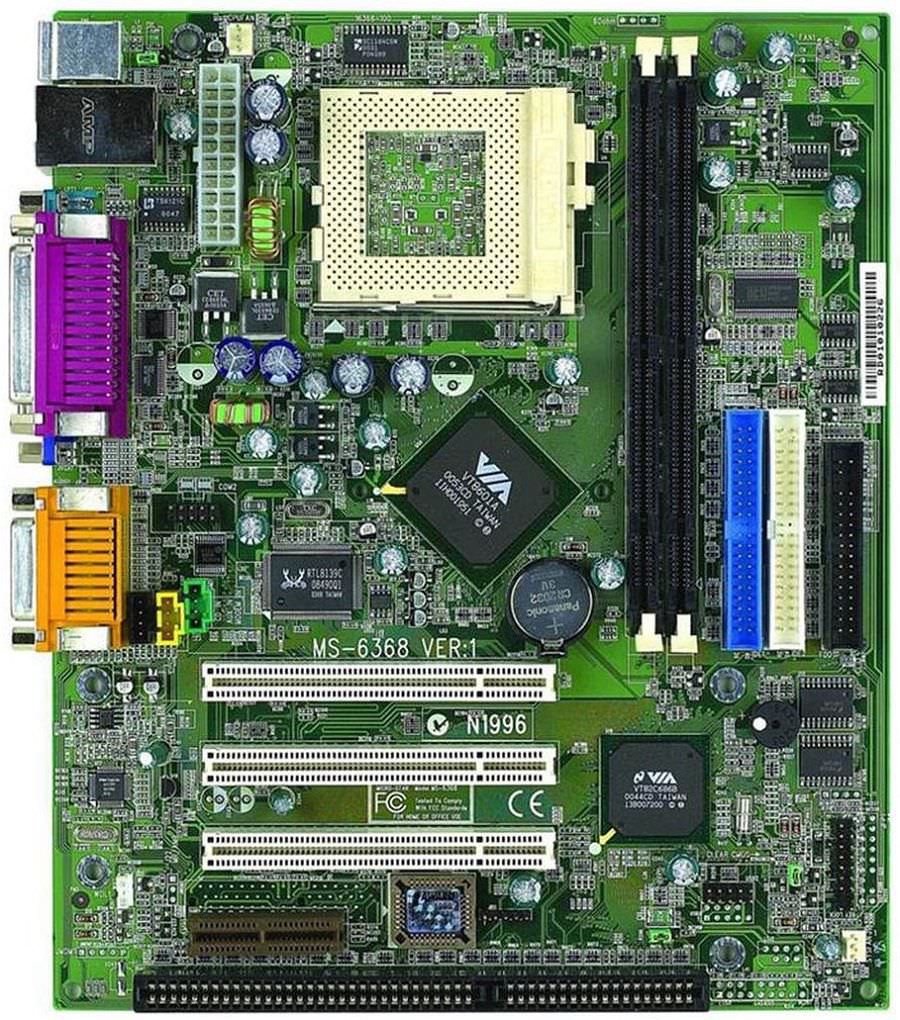
Old MSI motherboard for Pentium III processor, socket 370, and famous Via Apollo PLE133 chipset
Sometimes more than one chip suite is built for each generation of processors that support the same series of processors for the same generation but differ in peripherals. For example, Intel chipsets always support processor overclocking and main memory, especially in high-end and expensive models like the Z series (like the Z390 / Z490 ), which have the largest number of SATA ports and side ports like USB 3.0 and have faster expansion slots.
Full enjoy. Mid-range models have no overclocking capabilities but with many side ports ( H370 / H170 ). Mid-range models ( H310 / H110 ) always have the least bandwidth for accessories and anything controlled via the South Bridge. Are.
But regardless of the classification of chipsets produced for each generation of processors, it is important to know that some can use for two or more generations. Still, in this case, they are not subject to specific rules.
For example, the chip suite typically supports two or three generations of processors (especially the Raizen processor generation). Still, some Intel chipsets have a history of only one generation and one series of chips (such as the Z390 for the ninth generation of Core i3-9100 processors). Up to Core i9-9900K, which does not support 10th generation processors such as the Core i9-10900K ).
Some chips, such as the Z370 and B360, are also from Core series processors’ eighth and ninth generations. Have been supported and can be purchased for the latest processor models for at least two years.
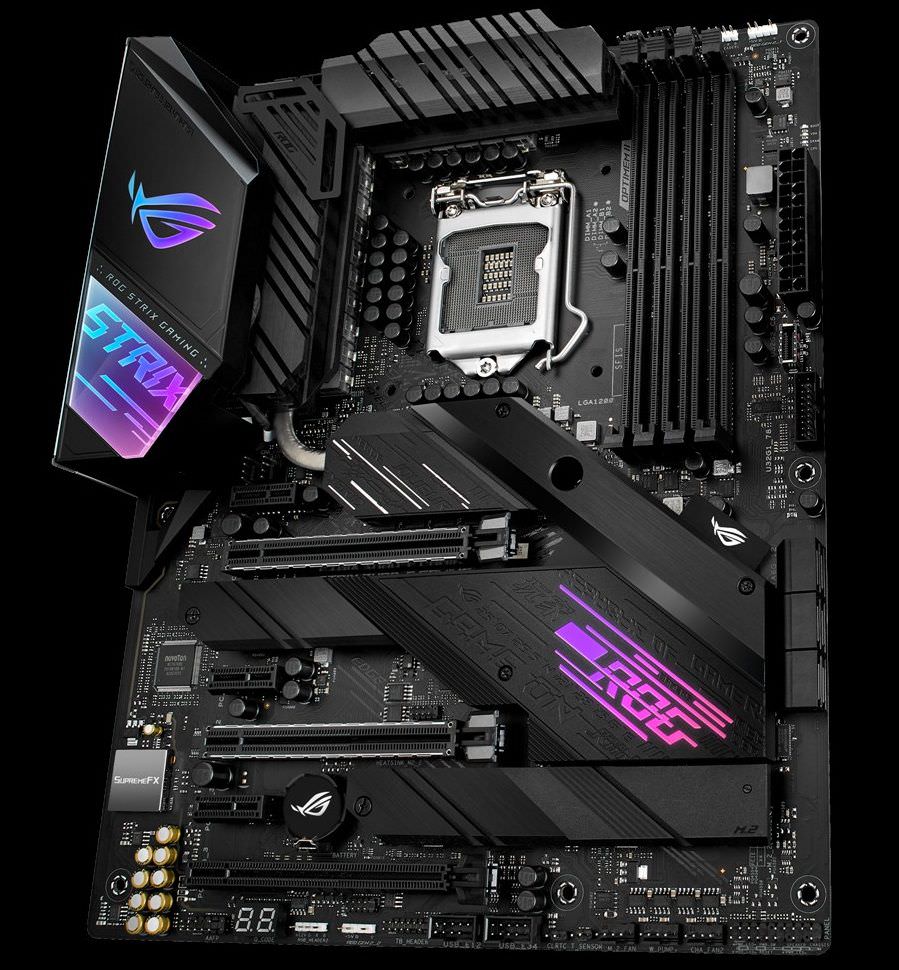
The latest generation of Asus motherboards with Z490 chipset for 10th generation Intel processors and LGA 1200 socket
However, it is not possible to consider general and long-term rules for determining the compatibility of chipsets with any series of processors. The best solution when buying is always to check the compatibility of the processor with the chipset at the site of the CPU manufacturer and motherboard manufacturer.
For example, for seventh-generation processors such as the Core i3-7100, a Google search, and referral to the Intel site show that motherboards use the 100 and 200 series chipsets, such as the H170 and Z270, can run and use our processor. Still, this version of the BIOS will support our CPU on our motherboard, which releases earlier than our CPU. It is exactly the information that can only understand in the Support section of the same motherboard model on the manufacturer’s site.
Therefore, updating the motherboard BIOS is usually one of the essential options for the proper functioning of our PC after complete assembly when buying newer processors than the year of release of the motherboard.
Which motherboards are more efficient?
It is a common misconception among many users that they will choose expensive motherboards for PC use, regardless of their needs, to get the best possible performance from the processor and other components.
In the distant past, when various manufacturers outside the processor manufactured the memory controller, this was quite noticeable and proven because sometimes motherboards made with secondary chips and lower efficiency than motherboards made from other manufacturers. They had Intel with their chipset. But this formula has not been true for many years.
We now know that the difference between different motherboards is simply because of their peripherals and the components needed to implement these capabilities on the board.
Features include more powerful power supply circuits for overclocking and higher quality electronic components for more heat resistance, control chips for more sensors, higher quality audio codec decoding chips, and RGB lighting controllers installed in more expensive motherboards.
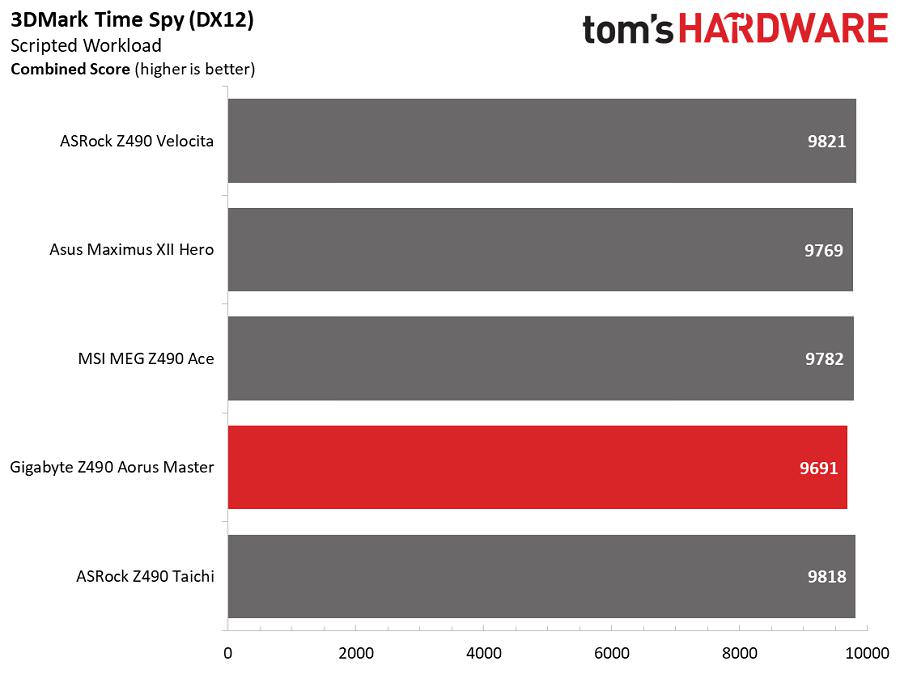
Z490 Multi-Motherboard Performance Chart from Manufacturers in 3DMark Test and Time Spy Test for DirectX 12
The efficiency difference between a $ 150 motherboard and a $ 500 motherboard is not as great as the manufacturers try to induce.
But where are the differences in the unique efficiency manufacturers trying to promote for some of their flagship models? The fact is that the difference in efficiency between the $ 150 motherboard and the $ 500 motherboard is not as great as the manufacturers are trying to induce.
Test both these motherboards and even other manufacturers with the same settings and only one processor in different benchmarks. You will see that the maximum difference will generally be in the range of 5 to 10%. Despite the same results, you can Evaluate overall performance at a level, except in special cases where the storage efficiency or an accessory is involved in the test, and a manufacturer has not optimized its motherboard for best performance with a particular SSD or peripheral, or with a compatibility problem with the model. Has been updated.
Some manufacturers also have a long history of covertly manipulating the settings and imperceptible overclocking of the processors installed on their motherboard to obtain higher rankings in the performance review charts and show themselves superior to others.
One of these hidden optimizations is a slight increase in base frequency or BCLK from 100 MHz to 100.4 or 100.5 MHz or even higher, significantly increasing the CPU operating frequency.
For example, if the CPU coefficient is 46, its operating frequency will be 4600 MHz (46 x 100), but if the BCLK has increased to 100.5, the CPU operating frequency will be 4623 MHz, which may not seem like much in the numbers. , But can change some benchmarks even with a small and imperceptible distance.
Also, the values related to the power consumption limit are another feature determined for each model separately by the processor manufacturer. Still, its implementation is the responsibility of the motherboard manufacturer.
According to some experts, this optimization method is also a type of cheat. The time limit and the amount of power consumption at high frequencies that Power limit is read, converted to higher or even unlimited values according to the decision of the motherboard manufacturer. For example, if a 125-watt processor wants to operate at turbo frequency and with all its active cores, its power will reach over 200 watts, which is not intended for the processor in the long run, so the operating frequency must be short to Decreased to the point where it falls below the intended power level.
But motherboard manufacturers can configure their products so that the amount intended for the Power Limit, or PL for short, is unlimited. The processor will never be reduced to a lower level over time, thus achieving much higher efficiencies.
It seems to be higher, of course, but it has consequences.
The biggest consequence of this optimization, overt or covert increase in power consumption and heat increases the chance of instability in the CPU, will always be the settings in the motherboard BIOS to deactivate these changes and match the reference model maker CPU. Still, many users These differences are ignorant and only complain about the high temperature of the processor during heavy load and mistakenly blame Intel or Imedi.
When choosing the right motherboard and chipset, the most important thing for us is to pay attention to our priorities and application needs when working with the system. Whether we are considering CPU overclocking or not, using RAM at a higher frequency than the manufacturer’s standard will help increase our efficiency in certain software. How many development slots do we need on the motherboard?
Or are we sensitive to the analog output quality of the motherboard sound card? How many high-speed USB ports do we need?
Is there an RGB lighting controller we need full color for fans with this capability?
How many case fans should be controlled by the fan connectors on the motherboard? These are all questions that should consider before buying a motherboard and when reviewing the specifications of the models. In addition, preferences such as familiarity and experience of working with the BIOS of one manufacturer or the ability to use advanced settings in the BIOS of another manufacturer can also lead users to buy a product of a reputable brand.












